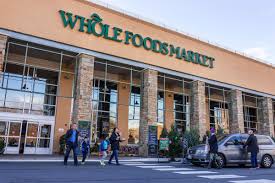Amazon’s Whole Foods Deal Just Validated the Brick-and-Mortar Retail Model

Amazon.com Inc.’s (NASDAQ:AMZN) decision to buy Whole Foods Market Inc. (NASDAQ:WFM) for $ 13.7 billion threw a wrench in the U.S. grocery market. The $ 800 billion grocery market is highly competitive with the likes of Wal-Mart Stores Inc. (NYSE:WMT), Kroger Co. (NYSE:KR), Costco Wholesale Corp. (NASDAQ:COST), Target Corp. (NYSE:TGT), Whole Foods and many others in the fray.
Grocery stocks were hit hard after the announcement, and even Walmart was not spared.
In terms of size, Walmart holds 14.5% of the food and grocery market, Kroger has 7.2% and Whole Foods has 1.2% market share. But Kroger’s stock, which was already under pressure due to the company’s weak outlook for the rest of the year, sharply declined following the announcement. In addition, the stock has declined by more than 35% in the last year.
Amazon’s entry will indeed shake up the market. To have a company that chases volume instead of margins as a competitor is bound to make things difficult. Margins will be squeezed, and the market is already under pressure due to deflation.
But is everything lost for grocery stocks due to Amazon’s impending entry into the space? Not so much.
For starters, Whole Foods accounts for just 1.2% of the market, and only 7% of U.S. consumers shopped online for groceries last month according to data from NPD Group. A good portion of that online shopping is likely to have been done by Amazon Prime members.
If the Whole Foods acquisition goes through, Amazon will put all its muscle behind it to expand the store footprint, increase its online grocery sales, cut down delivery times and maybe even get its cashier-less Amazon Go concept to move forward. But none of that is going to happen overnight. It will take months, if not years, for Amazon to capture market share. It has the money, the platform and the expertise, but it needs at least a few years to get close to 10% market share in the United States.
From that perspective, the current set of brick-and-mortar players have an advantage in the grocery segment – experience. The sooner they get their acts together, the more successful they will be in challenging the leader – as well as the company that wants to become the leader.
Without a doubt, the industry will see lot of consolidation, with weaker players making way for stronger ones. The bigger players, due to their size and cash flow, have better odds of competing in what is soon to become a hyper-competitive space.
But to write off all brick-and-mortar stores would be huge mistake. The fact Amazon wants to buy Whole Foods is, in itself, a huge validation for brick-and-mortar stores. If you want to be in the grocery business, there is no way you can do it without having a network of physical stores. That is the lesson Amazon has learned after 10 years of trying to break into this industry.
Disclosure: I have no positions in the stock mentioned above and have no intention of initiating a position in the next 72 hours.


